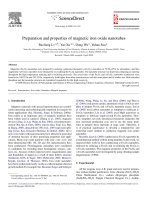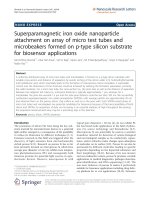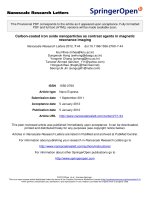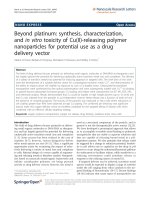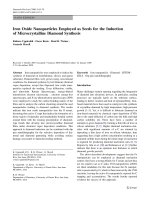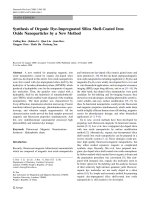Surface functionalization of superparamagnetic iron oxide nanoparticles for potential cell targeting, imaging, and cancer therapy applications
Bạn đang xem bản rút gọn của tài liệu. Xem và tải ngay bản đầy đủ của tài liệu tại đây (5.16 MB, 191 trang )
SURFACE FUNCTIONALIZATION OF SUPERPARAMAGNETIC
IRON OXIDE NANOPARTICLES FOR POTENTIAL CELL
TARGETING, IMAGING, AND CANCER THERAPY
APPLICATIONS
HUANG CHAO
NATIONAL UNIVERSITY OF SINGAPORE
2012
SURFACE FUNCTIONALIZATION OF SUPERPARAMAGNETIC
IRON OXIDE NANOPARTICLES FOR POTENTIAL CELL
TARGETING, IMAGING, AND CANCER THERAPY
APPLICATIONS
HUANG CHAO
(B.ENG., TIANJIN UNIVERSITY)
A THESIS SUBMITTED
FOR THE DEGREE OF DOCTOR OF PHILOSOPHY
DEPARTMENT OF CHEMICAL AND BIOMOLECULAR
ENGINEERING
NATIONAL UNIVERSITY OF SINGAPORE
2012
I
ACKNOWLEDGEMENTS
My sincere and deep gratitude goes first and foremost to my supervisor, Professor
Neoh Koon Gee, for her inspired guidance, valuable suggestions, insightful criticism,
great patience, and constant encouragement and support throughout the entire period
of my research study. Her enthusiasm, rigorous attitude and dedication to scientific
research are strongly impressed on my memory. Her expert advices greatly help me
improve the depth of my research. The profound and invaluable knowledge that I
gained from her will benefit me in my future life and career.
I am also very grateful to Professor Kang En-Tang for his kindly permission to
access the equipments in his research lab.
Further sincere thanks go to all my friends and colleagues for their assistance and
support. In particular, big thanks go to Dr. Wang Liang for sharing with me his
invaluable experience in the research field. I also owe a debt of gratitude to the lab
officers and technical staff of Department of Chemical and Biomolecular Engineering,
especially Dr. Yuan Zeliang, Mr. Chia Phai Ann, Dr. Yang Liming, Ms Xu Yanfang
and Mr. Chan Chuin Mun for their kindly help during my research. The research
scholarship for Ph.D study provided by National University of Singapore is also
greatly appreciated.
Finally, I would like to express my deepest gratitude to my beloved parents, my
husband, and other relatives for their unconditional love and support.
II
TABLE OF CONTENTS
ACKNOWLEDGEMENTS I
TABLE OF CONTENTS II
SUMMARY VII
LIST OF ABBREVIATIONS VIII
LIST OF FIGURES X
LIST OF TABLES XV
CHAPTER 1 INTRODUCTION 1
1.1 Background 2
1.2 Research Objectives and Scopes 3
CHAPTER 2 LITERATURE REVIEW 5
2.1 SPIONs 6
2.1.1 Basic Properties of SPIONs 6
2.1.2 Synthesis of SPIONs 8
2.1.2.1 Co-precipitation 8
2.1.2.2 Thermal Decomposition 10
2.1.3 Challenges of SPIONs for Biomedical Applications 11
2.2 Surface Functionalization of SPIONs 14
2.2.1 Materials for Surface Modification of SPIONs 15
2.2.1.1 Monomer Stabilizers 15
2.2.1.2 Polymer Stabilizers 17
2.2.1.3 Inorganic Stabilizers 18
2.2.2 Methods for Surface Modification of SPIONs 20
2.2.2.1 Self-assembly 20
2.2.2.2 Surface-initiated Controlled Polymerization 22
III
2.3 Biomedical Applications of SPIONs 24
2.3.1 MRI 24
2.3.2 Drug/Gene Delivery 28
2.3.3 Hyperthermia 31
CHAPTER 3 SURFACE FUNCTIONALIZATION OF
SUPERPARAMAGNETIC NANOPARTICLES FOR MODULATION OF
MACROPHAGE UPTAKE 33
3.1 Introduction 34
3.2 Materials and Methods 36
3.2.1 Materials 36
3.2.2 Preparation of SPIONs 36
3.2.3 Synthesis of PLMA Copolymers 37
3.2.4 Synthesis of PLMA-PEG Copolymers 37
3.2.5 Preparation of PLMA-SPIONs and PLMA-PEG-SPIONs 38
3.2.6 In Vitro Quantification of Nanoparticles Uptake by Macrophages 38
3.2.7 Cytotoxicity Assay of Nanoparticles 40
3.2.8 MRI Experiments 40
3.2.9 Characterization 42
3.3 Results and Discussion 45
3.3.1 Characterization of PLMA 45
3.3.2 Characterization of PLMA-PEG 46
3.3.3 Characterization of PLMA-SPIONs 48
3.3.4 Characterization of PLMA-PEG-SPIONs 52
3.3.5 Uptake of PLMA-SPIONs by Macrophages 55
3.3.6 Uptake of PLMA-PEG-SPIONs by Macrophages 59
3.3.7 Cytotoxicity of Nanoparticles 61
3.3.8 Magnetic Properties of Nanoparticles and MR Relaxometry 62
IV
3.4 Conclusion 70
CHAPTER 4 SURFACE MODIFIED SUPERPARAMAGNETIC IRON OXIDE
NANOPARTICLES FOR HIGH EFFICIENCY FOLATE-RECEPTOR
TARGETING WITH LOW UPTAKE BY MACROPHAGES 71
4.1 Introduction 72
4.2 Materials and Methods 74
4.2.1 Materials 74
4.2.2 Preparation of SPIONs 74
4.2.3 Synthesis of Initiator 75
4.2.4 Synthesis of Initiator Coated SPIONs 76
4.2.5 Surface Initiated ATRP on SPIONs 76
4.2.6 Chemical Modification of Epoxy Groups with EDA 77
4.2.7 Folic Acid Conjugation 77
4.2.8 Cell Culture 78
4.2.9 In Vitro Evaluation of Uptake of Nanoparticles 78
4.2.10 Cytotoxicity Assay 79
4.2.11 MRI Experiments 79
4.2.12 Characterization 79
4.2.13 Statistical Analysis 80
4.3 Results and Discussion 81
4.3.1 Synthesis of SPIONs-PGMA-FA 81
4.3.2 Size and Zeta Potential of Nanoparticles 85
4.3.3 Magnetic Properties 87
4.3.4 Cellular Uptake of Nanoparticles 90
4.3.5 Cytotoxicity Assay 94
4.4 Conclusion 96
V
CHAPTER 5 COMBINED ATRP AND ‘CLICK’ CHEMISTRY FOR
DESIGNING LONG-CIRCULATING TUMOR-TARGETING
SUPERPARAMAGNETIC IRON OXIDE NANOPARTICLES 97
5.1 Introduction 98
5.2 Materials and Methods 100
5.2.1 Materials 100
5.2.2 Preparation of SPIONs 100
5.2.3 Preparation of Initiator-coated SPIONs. 100
5.2.4 Preparation of SPIONs-P(GMA-co-PEGMA) via ATRP 100
5.2.5 Preparation of SPIONs-P(GMA-co-PEGMA)-N
3
102
5.2.6 Preparation of Alkyne-functionalized FA 102
5.2.7 Preparation of SPIONs-P(GMA-co-PEGMA)-FA 103
5.2.8 Cell Culture 104
5.2.9 Cytotoxicity Assay 104
5.2.10 In Vitro Evaluation of Folate Receptor Targeting 104
5.2.11 Characterization 105
5.2.12 Statistical Analysis 106
5.3 Results and Discussion 107
5.3.1 Surface Characterization of SPIONs-P(GMA-co-PEGMA)-FA 107
5.3.2 Nanoparticle Size and Stability 113
5.3.3 Magnetic Property 116
5.3.4 Cytotoxicity Assay 117
5.3.5 In Vitro Cellular Uptake 118
5.4 Conclusion 122
CHAPTER 6 CISPLATIN-CONJUGATED MAGNETIC NANOPARTICLES
FOR POTENTIAL BLADDER CANCER THERAPY 123
6.1 Introduction 124
6.2 Materials and Methods 127
VI
6.2.1 Materials 127
6.2.2 Preparation of SPIONs 127
6.2.3 Synthesis of PCL 127
6.2.4 Synthesis of PCL-b-P(PMA-co-PEGMA) 128
6.2.5 Synthesis of PCL-b-P(PMA-click-MSA-co-PEGMA) 128
6.2.6 Preparation of SPIONs-loaded PNs 129
6.2.7 Preparation of Cisplatin-conjugated PNs (Pt-Fe-PNs) 129
6.2.8 In Vitro Cisplatin Release 130
6.2.9 Cell Culture 131
6.2.10 Cytotoxicity Evaluation 131
6.2.11 Cellular Uptake 132
6.2.12 Characterization 133
6.3 Results and Discussion 134
6.3.1 Synthesis of PCL-b-P(PMA-click-MSA-co-PEGMA) 135
6.3.2 Preparation of Fe-PNs and Pt-Fe-PNs 139
6.3.3 In Vitro Drug Release 142
6.3.4 In Vitro Cytotoxicity Evaluation 144
6.4 Conclusion 148
CHAPTER 7 CONCLUSIONS AND RECOMMENDATIONS FOR FUTURE
WORK 149
7.1 Conclusions 150
7.2 Recommendations for Future Work 153
REFERENCES 155
LIST OF PUBLICATIONS ARISING FROM PHD WORK 173
VII
SUMMARY
Superparamagnetic iron oxide nanoparticles (SPIONs) are very useful for biomedical
applications, such as magnetic resonance imaging (MRI), hyperthermia for cancer
therapy, cell targeting, drugs or gene delivery. However, once introduced into blood,
SPIONs will be captured by the macrophages and then rapidly cleared out from
circulation which can drastically reduce the efficiency of SPIONs-based diagnosis and
therapy. Therefore, the bio-interfaces of SPIONs are crucial for their biomedical
applications. The overall aim of this thesis is to modify SPIONs with different
polymers for potential cell targeting, MRI and cancer therapy applications. In the first
project, SPIONs were coated with either poly(DL-lactic acid-co-malic acid) (PLMA)
or poly(ethylene glycol)-conjugated PLMA (PLMA-PEG) to modulate uptake by
macrophages. PLMA-SPIONs are readily taken up by macrophages but the extent of
uptake can be reduced by increasing the PEG content of the PLMA-PEG coating. In
the second project, SPIONs were coated with either poly(glycidyl methacrylate) or
poly(glycidyl methacrylate-co-poly(ethylene glycol) methyl ether methacrylate)
combined with a targeting ligand, folic acid, to attain high selectivity in targeting
cancers with minimal uptake by macrophages. All these nanoparticles have low
cytotoxicity and exhibit higher MRI contrast effects than commercial agents. Finally,
SPIONs-loaded, cisplatin-conjugated polymeric nanoparticles were synthesized for
potential application against bladder cancer. These nanoparticles show
mucoadhesiveness, a sustained release of cisplatin over 4 days and can effectively
induce cytotoxicity against the bladder cancer cells.
VIII
LIST OF ABBREVIATIONS
ATRP Atom Transfer Radical Polymerization
BE Binding Energy
BPB Bladder Permeability Barrier
DLS Dynamic Light Scattering
DMF N,N’-Dimethylformamide
DMSO Dimethyl Sulfoxide
EDA Ethylenediamine
EPR Enhanced Permeability and Retention
FA Folic Acid
FT-IR Fourier Transform Infrared
GAG Glycoaminoglycan
GMA Glycidyl Methacrylate
GPC Gel Permeation Chromatography
ICP-MS Inductively Coupled Plasma-Mass Spectrometry
IDD Intravesical Drug Delivery
MPS Mononuclear Phagocyte System
MRI Magnetic Resonance Imaging
IX
MSA 2-Mercaptosuccinic Acid
MTT Methylthiazolyldiphenyl-tetrazolium Bromide
PCL Poly(ε-caprolactone)
PBS Phosphate Buffered Saline
PEG Poly(ethylene glycol)
PEGMA Poly(ethylene glycol) Methyl Ether Methacrylate
PLMA Poly(DL-lactic acid-co-malic acid)
PMA Propargyl Methacrylate
RAFT Reversible Addition/Fragmentation Chain Transfer
RES Reticuloendothelial System
SPIONs Superparamagnetic Iron Oxide Nanoparticles
TEM Transmission Electron Microscopy
TGA Thermogravimetric Analysis
THF Tetrahydrofuran
VSM Vibrating Sample Magnetometer
XPS X-ray Photoelectron Spectroscopy
X
LIST OF FIGURES
Figure 2-1 Magnetic domains in a bulk material.
Figure 2-2 Schematic magnetization curves of (a) ferromagnetic nanoparticles
and (b) superparamagnetic nanoparticles.
Figure 2-3 In vivo behavior of nanoparticles in blood vessels. The EPR effect
of nanoparticles is greatest at tumors.
Figure 2-4 Size effects of SPIONs on magnetism and MR contrast effects.
Figure 2-5 Color maps of T
2
-weighted MR images of cancer cells implanted
mice at different temporal points after intravenous injection of
Herceptin-conjugated SPIONs. An immediate (5 min) color change
at the tumor site is evident.
Figure 2-6 A hypothetical magnetic drug delivery system shown in cross-
section: a magnet is placed outside the body in order that its
magnetic field gradient might capture magnetic carriers flowing in
the circulatory system.
Figure 2-7 Illustration of bladder permeability barrier established by uroplakin
covered umbrella cells of bladder epithelium (urothelium) and
GAG layer that prevents adhesion.
Figure 3-1 (a) Schematic representation of PLMA synthesis and (b)
1
H NMR
spectra of (i) PLMA-1, (ii) PLMA-2, and (iii) PLMA-3.
Figure 3-2 FT-IR spectra of (a) PLMA-1, (b) PLMA-1-PEG-1, (c) PLMA-1-
PEG-2, and (d) PLMA-1-PEG-3.
Figure 3-3 TEM images of (a) pristine SPIONs from high temperature
decomposition synthesis, (b) ~12 nm SPIONs after seed-mediated
growth of (a), and (c) PLMA-2-SPIONs.
Figure 3-4 FT-IR spectrum of ~12 nm SPIONs.
Figure 3-5 XPS C 1s core-level spectra of (a) pristine SPIONs and (b) PLMA-
2-SPIONs.
Figure 3-6 Schematic representation of the synthesis of PLMA-1-PEG-
SPIONs. Site and extent of amide band formation between H
2
N-
PEG and PLMA-1 are shown for illustration purpose only. TEM
images of (a) pristine SPIONs from high temperature
decomposition synthesis, (b) ~12 nm SPIONs from seed-mediated
growth of (a), and (c) PLMA-1-PEG-3-SPIONs.
XI
Figure 3-7 XPS C 1s core-level spectra of (a) pristine SPIONs, (b) PLMA-1-
SPIONs and (c) PLMA-1-PEG-3-SPIONs.
Figure 3-8 Images of macrophages incubated for 2 h (a) without PLMA-2-
SPIONs, and (b) with PLMA-2-SPIONs at an iron concentration of
0.5 mM, after staining with Prussian Blue.
Figure 3-9 Uptake of PLMA-2-SPIONs by macrophages (a) as a function of
incubation time at incubated iron concentration of 0.5 mM and (b)
as a function of incubated iron concentration for an incubation
period of 4 h. Inset is the image of macrophages incubated with
PLMA-2-SPIONs at an iron concentration of 2.0 mM for 4 h after
staining with Prussian Blue.
Figure 3-10 Effect of PEG content in the surface coating of SPIONs on uptake
by macrophages as a function of (a) incubation time ([Fe]=0.5
mM) and (b) incubated iron concentration at an incubation time of
4 h.
Figure 3-11 Viability of macrophages incubated with (a) nanoparticles with
different coatings at an iron concentration of 0.5 mM for 24 h and
(b) PLMA-1-SPIONs and PLMA-1-PEG-3-SPIONs at different
iron concentrations for 24 h. Viability is expressed as a percentage
relative to the result obtained with the non-toxic control
(macrophages incubated without nanoparticles).
Figure 3-12 Field dependent magnetization at 25°C for (a) pristine SPIONs, (b)
~12 nm SPIONs after seed-mediated growth, (c) PLMA-2-
SPIONs, and (d) PLMA-1-PEG-3-SPIONs.
Figure 3-13 Relaxation rates 1/T
1
(s
-1
) and 1/T
2
(s
-1
) in water as a function of
the iron concentration of (a) PLMA-2-SPIONs and (b) PLMA-1-
PEG-3-SPIONs (for all plots, correlation coefficient R
2
> 0.97).
Relaxometric measurements were performed by MRI.
Figure 3-14 MR images of phantoms containing (a) macrophages without
nanoparticles at a cell density of 200×10
3
cells/mL, and PLMA-2-
SPIONs-labeled macrophages at a cell density of (b) 6.3×10
3
, (c)
12.5×10
3
, (d) 50×10
3
and (e) 200×10
3
cells/mL.
Figure 3-15 Dependency of R
2
*
and R
2
on PLMA-2-SPIONs-labeled cell
concentration in phantoms (for both plots, correlation coefficient
R
2
> 0.97).
Figure 4-1 Schematic representation of the synthesis of SPIONs-PGMA-FA.
XII
Figure 4-2 A. XPS wide scan spectra of (a) oleic acid-stabilized SPIONs, (b)
initiator-coated SPIONs, (c) SPIONs-PGMA, and (d) SPIONs-
PGMA-NH
2
; B. XPS C 1s core-level spectra of (a) SPIONs-
PGMA and (b) SPIONs-PGMA-NH
2
.
Figure 4-3 FT-IR spectra of (a) oleic acid-stabilized SPIONs, (b) initiator-
coated SPIONs, (c) SPIONs-PGMA, (d) SPIONs-PGMA-NH
2
, (e)
SPIONs-PGMA-FA-1, and (f) free folic acid.
Figure 4-4 TEM images of (a) oleic acid-stabilized SPIONs dispersed in
hexane and (b) SPIONs-PGMA-FA-1 dispersed in DI water.
Figure 4-5 Field dependent magnetization at 25
o
C for (a) oleic acid-stabilized
SPIONs and (b) SPIONs-PGMA-FA-1.
Figure 4-6 A. T
2
-weighted MRI images (3T, spin-echo sequence: TR=3000
ms, TE=36.8 ms) of SPIONs-PGMA-FA-1 in water; B. Relaxation
rates (a) 1/T
2
and (b) 1/T
1
at a magnetic field of 3T as a function of
iron concentration (mM) of SPIONs-PGMA-FA-1 in water.
Figure 4-7 (a) Intracellular uptake of SPIONs-PGMA-NH
2
and SPIONs-
PGMA-FA-1 by KB cells as a function of incubation time; (b)
intracellular uptake of SPIONs-PGMA-FA nanoparticles with
different FA surface densities by different cell lines after
incubation of 4 h. Nanoparticle concentration in medium was 0.2
mg/mL. (*) denote significant differences between each pair
indicated (P < 0.05).
Figure 4-8 Viability of 3T3 fibroblasts, macrophages, and KB cells as a
function of SPIONs-PGMA-FA-1 concentration in medium.
Incubation period was 24 h.
Figure 5-1 Schematic representation of the synthesis of SPIONs-P(GMA-co-
PEGMA)-FA.
Figure 5-2 XPS wide-scan spectra of (a) initiator-coated SPIONs and (b)
pristine SPIONs.
Figure 5-3 XPS C 1s core-level spectra of (a) SPIONs-P(GMA-co-PEGMA),
(c) SPIONs-P(GMA-co-PEGMA)-N
3
, and (e) SPIONs-P(GMA-co-
PEGMA)-FA-3. XPS N 1s core-level spectra of (b) SPIONs-
P(GMA-co-PEGMA), (d) SPIONs-P(GMA-co-PEGMA)-N
3
, and
(f) SPIONs-P(GMA-co-PEGMA)-FA-3.
Figure 5-4 FT-IR spectra of (a) SPIONs-P(GMA-co-PEGMA), (b) SPIONs-
P(GMA-co-PEGMA)-N
3
, and (c) SPIONs-P(GMA-co-PEGMA)-
FA-3.
XIII
Figure 5-5 FT-IR spectra of (a) SPIONs-P(GMA-co-PEGMA)-FA-1 (b)
SPIONs-P(GMA-co-PEGMA)-FA-2, and (c) SPIONs-P(GMA-co-
PEGMA)-FA-3.
Figure 5-6 UV-vis absorption spectra of (a) SPIONs-P(GMA-co-PEGMA)-N
3
,
(b) SPIONs-P(GMA-co-PEGMA)-FA-1, (c) SPIONs-P(GMA-co-
PEGMA)-FA-2, and (d) SPIONs-P(GMA-co-PEGMA)-FA-3 in DI
water.
Figure 5-7 TEM images of (a) pristine oleic acid-stabilized SPIONs dispersed
in hexane, and (b) SPIONs-P(GMA-co-PEGMA)-FA-3 dispersed
in DI water.
Figure 5-8 Stability of SPIONs-P(GMA-co-PEGMA)-FA-3 in aqueous
solution of varying (a) salt concentration, and (b) pH.
Figure 5-9 Magnetization curves of (a) pristine oleic acid-stabilized SPIONs,
and (b) SPIONs-P(GMA-co-PEGMA)-FA-3 at 25
o
C.
Figure 5-10 In vitro viabilities of 3T3 fibroblasts, macrophages, and KB cells as
a function of SPIONs-P(GMA-co-PEGMA)-FA-3 concentration in
medium. Incubation period was 24 h.
Figure 5-11 (a) Intracellular uptake of SPIONs-P(GMA-co-PEGMA)-N
3
and
SPIONs-P(GMA-co-PEGMA)-FA-3 as a function of incubation
time, (*) denotes significant difference as compared to SPIONs-
P(GMA-co-PEGMA)-N
3
(negative control) (P < 0.05); (b)
intracellular uptake of SPIONs-P(GMA-co-PEGMA)-FA-3 by
different cell lines as a function of incubation time, (*) denotes
significant difference as compared to 3T3 fibroblasts (P < 0.05),
(#) denotes significant difference as compared to macrophages (P <
0.05); (c) specific uptake index of SPIONs-P(GMA-co-PEGMA)-
FA for different cell lines after incubation of 4 h. The index is
calculated as the ratio between the cellular uptake of SPIONs-
P(GMA-co-PEGMA)-FA and that of control nanoparticles
(SPIONs-P(GMA-co-PEGMA)-N
3
), (*) denotes significant
difference between each pair indicated (P < 0.05). Nanoparticle
concentration in medium was 0.2 mg/mL.
Figure 6-1 Structure of (a) cisplatin and (b) the chelate ring after coordination
with dicarboxylic groups.
Figure 6-2 Synthetic route for PCL-b-P(PMA-click-MSA-co-PEGMA).
Figure 6-3
1
H NMR spectra of (A) PCL, (B) PCL-b-P(PMA-co-PEGMA), and
(C) PCL-b-P(PMA-click-MSA-co-PEGMA)
.
Figure 6-4 FT-IR spectra of (a) PCL, (b) PCL-b-P(PMA-co-PEGMA), and (c)
PCL-b-P(PMA-click-MSA-co-PEGMA).
XIV
Figure 6-5 TEM images of (a) pristine oleic acid-stabilized SPIONs, (b) Fe-
PNs, and (c) Pt-Fe-PNs.
Figure 6-6 XPS Pt 4f core-level spectra of (a) Fe-PNs and (b) Pt-Fe-PNs.
Figure 6-7 Field dependent magnetization at 25
o
C for (a) pristine oleic acid-
stabilized SPIONs and (b) Pt-Fe-PNs.
Figure 6-8 Release profiles of cisplatin from Pt-Fe-PNs in DI water, PBS, and
artificial urine at 37
o
C. Inset shows the release profile in the first
10 h.
Figure 6-9 Size increase of a mixture of Pt-Fe-PNs and mucin after incubation
at 37
o
C for 2 h. Pure mucin and nanoparticle suspensions were
used as controls.
Figure 6-10 Fluorescence images of UMUC3 bladder cancer cells after 2 h
incubation with Pt-C6-PNs at [Pt]=10 μM. The images were
obtained from (a) FITC channel (green), (b) DAPI channel (blue),
and (c) combined with FITC and DAPI channels. Scale bar=100
μm.
Figure 6-11 In vitro cytotoxicity profile of (a) free cisplatin, (b) Fe-PNs, and Pt-
Fe-PNs against UMUC3 bladder cancer cells. Cells were exposed
to the drug or nanoparticles for 2 h and further cultured with fresh
medium for 72 h.
XV
LIST OF TABLES
Table 3-1 Molecular weight and PEG content of PLMA-1-PEG
copolymers.
Table 3-2 Properties of PLMA-SPIONs.
Table 3-3 Properties of PLMA-1-PEG-SPIONs.
Table 3-4 Relaxivities of cell-associated and free nanoparticles.
Table 5-1 Properties of nanoparticles.
Table 6-1 Molecular weight (g/mol) of polymers.
Chapter 1
1
CHAPTER 1 INTRODUCTION
Chapter 1
2
1.1 Background
Nanotechnology is one of the critical technologies of the 21st century, and it has
greatly enabled the design of advanced functional nanomaterials of dimensions of 1-
1000 nm in the biomedical field (Gupta and Gupta 2005). Among the different types
of nanomaterials, magnetic iron oxide nanoparticles are of intense current interest and
have been successfully used for clinical applications, for example, molecular imaging.
Magnetic iron oxide nanoparticles smaller than 100 nm are normally applied in
biomedical applications. In the case of magnetic iron oxide nanoparticles with
diameters less than 20 nm, the so-called superparamagnetic iron oxide nanoparticles
(SPIONs), these nanoparticles often show superparamagnetic behavior at room
temperature (Hao et al. 2010). SPIONs have many advantages, such as a high constant
magnetic moment with a fast response to applied magnetic field, as well as no
remnant magnetization in the absence of external magnetic field due to zero
randomization of magnetic moments by thermal agitation. Owing to these unique
features, SPIONs are very attractive and ideal for a broad range of biomedical
applications, such as magnetic resonance imaging (MRI) contrast enhancement,
drug/gene delivery, and hyperthermia in cancer treatment.
However, there are several problems for the application of pristine SPIONs in vivo.
Firstly, SPIONs synthesized by high-temperature decomposition method are
hydrophobic and intrinsically unstable over time in a biological environment, due to
their large surface-to-volume ratio (Oh and Park 2011). Moreover, the adsorption of
plasma proteins (e.g. immunoglobulins and fibronectin) on the surfaces of SPIONs
Chapter 1
3
leads to a non-specific uptake by the reticuloendothelial system (RES), e.g.
macrophages, resulting in a rapid elimination of SPIONs from the blood. The short
blood circulation time drastically reduces the efficiency of SPIONs-based diagnostics
and therapeutics. In addition, specific accumulation of SPIONs in target organs is also
required for cancer therapy via SPIONs-based drug delivery or hyperthermia, in order
to reduce the systemic toxicity associated with serious side-effects. Therefore, surface
coating of SPIONs to attain colloidal stability, prolonged blood circulation time, and
site-specific accumulation in target organs is crucial for SPIONs-based biomedical
applications.
1.2 Research Objectives and Scopes
The overall aim of this thesis is to develop various functional polymers as surface
coatings of SPIONs for potential cell targeting, MRI, and cancer therapy applications.
This thesis consists of seven chapters. In Chapter 1, a general introduction of the
current problems for SPIONs-based biomedical applications, the objectives and scope
of this study is provided while Chapter 2 gives an overview of the related literature.
Chapter 3 describes the research on the use of biocompatible and biodegradable
polymer coatings, poly(DL-lactic acid-co-malic acid) (PLMA) and poly(ethylene
glycol)-conjugated PLMA (PLMA-PEG), for the modulation of uptake of SPIONs by
macrophages. In Chapter 4, the focus is on SPIONs which can target cancers while
evading uptake by macrophages. The SPIONs are first coated with poly(glycidyl
methacrylate) (PGMA) via surface-initiated atom transfer radical polymerization
(ATRP). After ring-opening reaction with ethylenediamine, different amounts of
tumor-targeting ligand, folic acid (FA) are conjugated on the surface to attain high
Chapter 1
4
selectivity in targeting cancer cells. Chapter 5 gives an alternative method for
synthesizing FA-conjugated SPIONs for minimizing uptake by macrophages and
enhancing the selectivity in targeting of cancer cells. ATRP of GMA and
poly(ethylene glycol) methyl ether methacrylate (PEGMA) from the surface of
SPIONs was first carried out, followed by ‘click’ chemistry to conjugate FA with
controlled surface densities. In Chapter 6, the preparation of nanoparticles
incorporating SPIONs and drug for potential bladder cancer therapy is described.
Amphiphilic poly(ε-caprolactone)-b-poly(propargyl methacrylate-click-
mercaptosuccinic acid-co-poly(ethylene glycol) methyl ether methacrylate) (PCL-b-
P(PMA-click-MSA-co-PEGMA)) are synthesized via the combination of reversible
addition-fragmentation chain transfer (RAFT) polymerization and thiol-yne reaction.
This polymer was used to encapsulate SPIONs and coordinate cisplatin. The resulting
nanoparticles are mucoadhesive and provide sustained drug release. Finally, the
overall conclusion of the work and recommendations for future work are presented in
Chapter 7.
Chapter 2
5
CHAPTER 2 LITERATURE REVIEW
Chapter 2
6
2.1 SPIONs
The rapid growth of nanotechnology over the past decade provides exciting
possibilities for synthesis, characterization, and functionalization of nanoscale
materials for biomedical applications and diagnostics (Schladt et al. 2011). Among
the variety of promising nanoscale materials, SPIONs have gained significant
attention due to their great potential for various biomedical applications, including
MRI for cell targeting and monitoring, drug/gene delivery, hyperthermia for cancer
treatment, etc. In addition, in contrast to other inorganic nanoparticles, SPIONs are
biocompatible, since the iron from degraded SPIONs can be incorporated in the
natural iron stores of the body, such as hemoglobin (Veiseh et al. 2011).
2.1.1 Basic Properties of SPIONs
Bulk ferromagnetic materials, which exhibit a permanent magnetization (M) in the
absence of a magnetic field, contain multi domains (Figure 2-1). Due to the different
alignment of atomic magnetic moments within the domain, the overall magnetization
decreases. Under an external magnetic field H, M of the ferromagnetic materials
increases with H until a saturation magnetization M
s
is reached. When H is decreased
to zero, a remnant magnetization (M
r
) is present. A hysteresis loop can be observed in
the magnetization curve of ferromagnetic materials as shown in Figure 2-2a.
As the size of a ferromagnet decreases, a critical size will be reached such that the
particle contains a single domain with all the spins uniformly aligned in the same
direction (Lu et al. 2007). For a single domain particle, an energy barrier of KV has to
be overcome in order to reverse the directions of magnetization, where K is the
Chapter 2
7
effective anisotropy constant and V is the particle volume (Lu et al. 2007). When the
particle size is decreased, the thermal energy K
B
T, where K
B
is the Boltzman constant
and T is the temperature, exceeds the energy barrier KV, leading to randomization of
the magnetization in any direction (Crooks 1979). This phenomenon is called
superparamagnetism. No hysteresis loop is present in the magnetization curve of
superparamagnetic particles (Figure 2-2b). On the other hand, when the temperature
decreases until K
B
T < KV, the particle undergoes a transition from a
superparamagnetic to a so-called blocked state. The temperature at which K
B
T = KV is
called blocking temperature T
B
.
Figure 2-1 Magnetic domains in a bulk material (Teja and Koh 2009).
Iron oxide nanoparticles at diameter smaller than around 20 nm often display
superparamagnetic behavior at room temperature. Due to the zero net magnetization
as a result of thermal agitation after removal of an external magnetic field,
aggregation concerns resulting from magnetic interaction are minimized. Therefore,
SPIONs are deemed very useful for biomedical applications.


